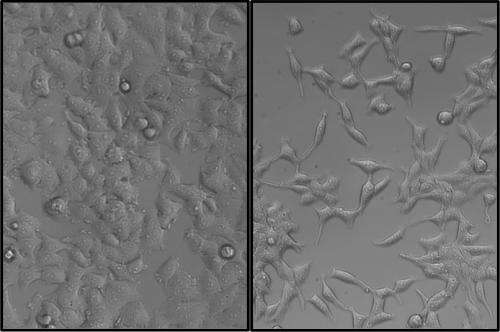Study shows how breast cancer cells break free to spread in the body

More than 90 percent of cancer-related deaths are caused by the spread of cancer cells from their primary tumor site to other areas of the body. A new study has identified how one important gene helps cancer cells break free from the primary tumor.
A gene normally involved in the regulation of embryonic development can trigger the transition of cells into more mobile types that can spread without regard for the normal biological controls that restrict metastasis, the new study shows.
Analysis of downstream signaling pathways of this gene, called SNAIL, could be used to identify potential targets for scientists who are looking for ways to block or slow metastasis.
"This gene relates directly to the mechanism that metastatic cancer cells use to move from one location to another," said Michelle Dawson, an assistant professor in the School of Chemical and Biomolecular Engineering at the Georgia Institute of Technology. "If you have a cell that overexpresses SNAIL, then it can potentially be metastatic without having any environmental cues that normally trigger this response."
The study was sponsored by the National Science Foundation (NSF) and was published December 9 in the Journal of the Federation of American Societies for Experimental Biology (FASEB).
Previously, Dawson and Daniel McGrail, the lead author on the new study, published a study showing how ovarian cancer cells respond to the mechanics of their bodily environment. Their data showed that ovarian cancer cells are more aggressive on soft tissues - such as the fatty tissue that line the gut - due to the mechanical properties of this environment. The finding is contrary to what is seen with other malignant cancer cells that seem to prefer stiffer tissues.
In the new study, the researchers show how overexpression of the gene SNAIL in vitro allows breast cancer cells to operate independently of the mechanics of the environment inside the body. Growing evidence suggests that cancer cells metastasize by hijacking the process by which cells change their type from epithelial (cells that lack mobility) to mesenchymal (cells that can easily move). In the new study, the researchers examined the biophysical properties of breast cancer cells that had undergone this epithelial to mesenchymal transition (through overexpression of SNAIL).
The research team measured the mechanical properties within the nucleus and cytosol of breast cancer cells, and then measured the surface traction forces and the motility of the cells on different substrates. They found that cells became much softer, which could help them spread throughout the body.
Dawson's lab collaborated with the lab of John McDonald, a professor in the School of Biology at Georgia Tech, to use microarray analysis to examine changes in genes related to the observed biophysical changes. The researchers found that regardless of the substrate that the cells were grown on, cells that overexpress SNAIL look and act like aggressive cancer cells.
"We found that when the cells express SNAIL, they have biophysical properties that are similar to what we see for an activated metastatic cancer cell," Dawson said.
Although SNAIL triggers a transformation that helps cells move from the primary tumor to the metastatic site, once the cell arrives at the metastatic site and that tumor starts to grow, SNAIL no longer helps cancer progress. Though becoming softer may help cells spread to the secondary site, they were no longer sturdy enough to form a secondary tumor.
"The cells need to transfer back to the epithelial state so they can withstand solid stress," Dawson said.
The researchers hope that their unique blend of microarray analysis and characterization of physical changes in breast cancer cells undergoing metastasis could aid the search for ways to block or slow the spread of cancer.
"We think this work has great potential to lead to a new approach to cancer therapeutics," said McDonald, who is also the director of the Integrated Cancer Research Center at Georgia Tech.
More information: Daniel J. McGrail, et al., "SNAIL-induced epithelial-to-mesenchymal transition produces concerted biophysical changes from altered cytoskeletal gene expression." (FASEB, December 2014) www.fasebj.org/content/early/2 … j.14-257345.abstract



















